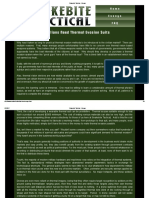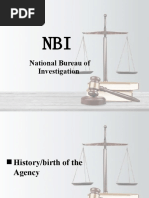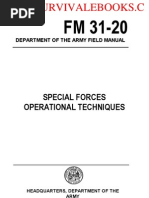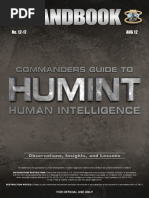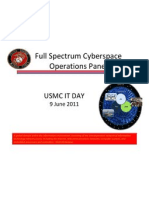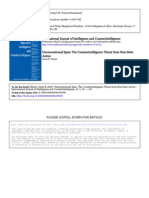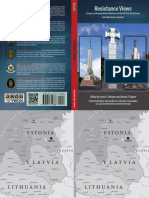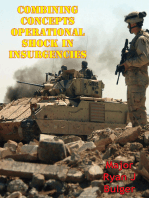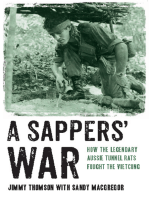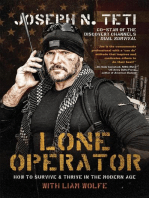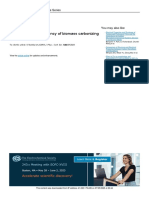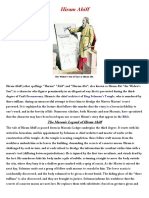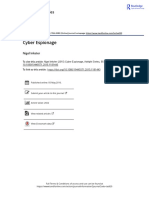Special Operations Forces (SOF) and CIA Paramilitary Operations: Issues For Congress
Special Operations Forces (SOF) and CIA Paramilitary Operations: Issues For Congress
Uploaded by
Emmanuel MatutuCopyright:
Available Formats
Special Operations Forces (SOF) and CIA Paramilitary Operations: Issues For Congress
Special Operations Forces (SOF) and CIA Paramilitary Operations: Issues For Congress
Uploaded by
Emmanuel MatutuOriginal Title
Copyright
Available Formats
Share this document
Did you find this document useful?
Is this content inappropriate?
Copyright:
Available Formats
Special Operations Forces (SOF) and CIA Paramilitary Operations: Issues For Congress
Special Operations Forces (SOF) and CIA Paramilitary Operations: Issues For Congress
Uploaded by
Emmanuel MatutuCopyright:
Available Formats
Special Operations Forces (SOF) and CIA
Paramilitary Operations: Issues for Congress
Richard A. Best Jr.
Specialist in National Defense
Andrew Feickert
Specialist in Military Ground Forces
August 3, 2009
Congressional Research Service
7-5700
www.crs.gov
RS22017
CRS Report for Congress
Prepared for Members and Committees of Congress
Special Operations Forces (SOF) and CIA Paramilitary Operations: Issues for Congress
Summary
The 9/11 Commission Report recommended that responsibility for directing and executing
paramilitary operations should be shifted from the CIA to the U.S. Special Operations Command
(USSOCOM). The President directed the Secretary of Defense and Director of Central
Intelligence to review this recommendation and present their advice by mid-February 2005, but
ultimately, they did not recommend a transfer of paramilitary responsibilities. This Report will
briefly describe special operations conducted by DOD and paramilitary operations conducted by
the CIA and discuss the background of the 9/11 Commission’s recommendations. For additional
information see CRS Report RS21048, U.S. Special Operations Forces (SOF): Background and
Issues for Congress, by Andrew Feickert.
Congressional Research Service
Special Operations Forces (SOF) and CIA Paramilitary Operations: Issues for Congress
Contents
What Are Special Operations and Paramilitary Operations?...................................................1
Roles and Mission of CIA and SOF.......................................................................................1
Brief History of CIA and SOF Paramilitary Operations .........................................................2
CIA.................................................................................................................................2
SOF ................................................................................................................................2
9/11 Report Recommendations..............................................................................................3
Potential Impacts...................................................................................................................3
Diminished CIA Intelligence Capabilities........................................................................3
Additional Strain on SOF ................................................................................................4
A Reduction in Flexibility ...............................................................................................4
SOF Funding Authority...................................................................................................4
Issues for Congress ...............................................................................................................4
Oversight Issues..............................................................................................................4
Potential Legal Considerations ........................................................................................5
Congressional Activity ..........................................................................................................5
109th Congress ................................................................................................................5
110th Congress ................................................................................................................6
111th Congress.................................................................................................................6
Contacts
Author Contact Information ........................................................................................................6
Congressional Research Service
Special Operations Forces (SOF) and CIA Paramilitary Operations: Issues for Congress
T he U.S. strategy in pursuing the war on international terrorism involves a variety of
missions conducted by military and civilian intelligence personnel characterized as
“special operations” or paramilitary operations. The separate roles of the Department of
Defense (DOD) and the Central Intelligence Agency (CIA) are not always clearly reflected in
media accounts and at times there has been considerable operational overlap. Proposals such as
those made by the 9/11 Commission to change organizational relationships will, however, be
evaluated on the basis of separate roles and missions, operating practices, and relevant statutory
authorities.
What Are Special Operations and Paramilitary Operations?
DOD defines special operations as “operations conducted in hostile, denied, or politically
sensitive environments to achieve military, diplomatic, informational, and/or economic objectives
employing military capabilities for which there is no broad conventional force requirement.”1
DOD defines paramilitary forces as “forces or groups distinct from the regular armed forces of
any country, but resembling them in organization, equipment, training or mission.” In this report,
the term “paramilitary operations” will be used for operations conducted by the CIA whose
officers and employees are not part of the armed forces of the United States. (In practice, military
personnel may be temporarily assigned to the CIA and CIA personnel may temporarily serve
directly under a military commander.)
In general, special operations are distinguishable from regular military operations by degree of
physical and political risk, operational techniques, and mode of employment among other factors.
DOD special operations are frequently clandestine—designed in such a way as to ensure
concealment; they are not necessarily covert, that is, concealing the identity of the sponsor is not
a priority. The CIA, however, conducts covert and clandestine operations to avoid directly
implicating the U.S. Government.
Roles and Mission of CIA and SOF
USSOCOM was established by Congress in 1987 (P.L. 99-661, 10 U.S.C. §167). USSOCOM’s
stated mission is to plan, direct and execute special operations in the conduct of the War on
Terrorism in order to disrupt, defeat, and destroy terrorist networks that threaten the United
States.2
The CIA was established by the National Security Act of 1947 (P.L. 80-253) to collect
intelligence through human sources and to analyze and disseminate intelligence from all sources.
It was also to “perform such other functions and duties related to intelligence affecting the
national security as the President or the National Security Council may direct.” This opaque
phrase was, within a few months, interpreted to include a range of covert activities such as those
that had been carried out by the Office of Strategic Services (OSS) during World War II. Although
some observers long maintained that covert actions had no statutory basis, in 1991 the National
1
Definitions are from Joint Publication 1-02, “Department of Defense Dictionary of Military and Associated Terms,”
Apr. 12, 2001, as amended through Oct. 7, 2004.
2
Taken from United States Special Operation Forces Posture Statement 2003-2004, U.S. Special Operations
Command, pp. 4-10.
Congressional Research Service 1
Special Operations Forces (SOF) and CIA Paramilitary Operations: Issues for Congress
Security Act was amended (by P.L. 102-88) to establish specific procedures for approving covert
actions and for notifying key Members of Congress.
The statutory definition of covert action (“activity or activities of the United States Government
to influence political, economic, or military conditions abroad, where it is intended that the role of
the United States Government will not be apparent or acknowledged publicly....”) is broad and
can include a wide range of clandestine efforts—from subsidizing foreign journals and political
parties to participation in what are essentially military operations. In the case of paramilitary
operations, there is a clear potential for overlap with activities that can be carried out by DOD. In
general, the CIA would be designated to conduct operations that are to be wholly covert or
disavowable. In practice, responsibilities for paramilitary operations have been assigned by the
National Security Council on a case-by-case basis.
Brief History of CIA and SOF Paramilitary Operations
CIA
In addition to acquiring intelligence to support US military operations from the Korean War era to
Iraq today, the CIA has also worked closely alongside DOD personnel in military operations. On
occasion it has also conducted clandestine military operations apart from the military. One
example was the failed Bay of Pigs landing in Cuba in 1961. Especially important was a
substantial CIA-managed effort in Laos in the 1960s and 1970s to interdict North Vietnamese
resupply efforts. The CIA was directed to undertake this effort in large measure to avoid the onus
of official U.S. military intervention in neutral Laos. The CIA’s paramilitary operations in
Afghanistan in 2001 have been widely described; CIA officers began infiltrating Afghanistan
before the end of September 2001 and played an active role alongside SOF in bringing down the
Taliban regime by the end of the year. According to media reports, the CIA has also been
extensively involved in operations in Iraq in support of military operations.3
SOF
SOF have reportedly been involved in clandestine and covert paramilitary operations on
numerous occasions since the Vietnam War. Operations such as the response to the TWA 847 and
Achille Lauro highjackings in 1985, Panama in 1989, Mogadishu in 1993, and the Balkans in the
late 1990s have become public knowledge over time but other operations reportedly remain
classified to this day. 4 Some speculate that covert paramilitary operations would probably become
the responsibility of a number of unacknowledged special operations units believed to exist
within USSOCOM.5
3
See Barton Gellman and Dafna Linzer, “Afghanistan, Iraq: Two Wars Collide,” Washington Post, Oct. 22, 2004, p.
A1; Bob Woodward, Plan of Attack (New York: Simon & Schuster, 2004), especially pp. 301-306, 373-376; Gary C.
Schroen, First In: An Insider’s Account of How the CIA Spearheaded the War on Terror in Afghanistan (New York:
Ballantine Books, 2005).
4
Col. John T. Carney, Jr. and Benjamin F. Schemmer, No Room for Error: The Covert Operations of America’s
Special Tactics Units from Iran to Afghanistan, 2002, pp. ix -x.
5
Jennifer D. Kibbe, “The Rise of the Shadow Warriors,” Foreign Affairs, March/April 2004, vol. 83, no. 2, p. 110.
Congressional Research Service 2
Special Operations Forces (SOF) and CIA Paramilitary Operations: Issues for Congress
9/11 Report Recommendations6
Recommendation 32 of the 9/11 Commission report states: “Lead responsibility for directing and
executing paramilitary operations, whether clandestine or covert, should shift to the Defense
Department. There it should be consolidated with the capabilities for training, direction, and
execution of such operations already being developed in the Special Operations Command.” The
9/11 Commission’s basis for this recommendation appears to be both performance and cost-
based. The report states that the CIA did not sufficiently invest in developing a robust capability
to conduct paramilitary operations with U.S. personnel prior to 9/11, and instead relied on
improperly trained proxies (foreign personnel under contract) resulting in an unsatisfactory
outcome. The report also states that the United States does not have the money or people to build
“two separate capabilities for carrying out secret military operations,” and suggests that we
should “concentrate responsibility and necessary legal authorities in one entity.”
Some observers question whether procedures are in place to insure overall coordination of effort.
Press reports concerning an alleged lack of coordination during Afghan operations undoubtedly
contributed to the 9/11 Commission’s recommendation regarding paramilitary operations. 7
Although such accounts have been discounted by some observers, the Intelligence Reform and
Terrorism Prevention Act (P.L. 108-458) included a provision (Section 1013) that requires DOD
and CIA to develop joint procedures “to improve the coordination and deconfliction of operations
that involve elements” of the CIA and DOD. When separate missions are underway in the same
geographical area, the CIA and DOD are required to establish procedures to reach “mutual
agreement on the tactical and strategic objectives for the region and a clear delineation of
operational responsibilities to prevent conflict and duplication of effort.”
Potential Impacts
Diminished CIA Intelligence Capabilities
Some observers suggest that a capability to plan and undertake paramilitary operations is directly
related to the Agency’s responsibility to obtain intelligence from human sources. Some
individuals and groups that supply information may also be of assistance in undertaking or
supporting a paramilitary operation. If CIA were to have no responsibilities in this area, however,
certain types of foreign contacts might not be exploited and capabilities that have proven
important (in Afghanistan and elsewhere) might erode or disappear.8
6
Taken from The 9/11 Commission Report (Washington: GPO, 2004) pp. 415 - 416.
7
See, for instance, Jonathan Weisman, “CIA, Pentagon Feuding Complicates War Effort,” USA Today, June 17, 2002,
p. 11. Another account cites CIA claims that the DOD command process is “bureaucratic and slow-rolling because of
an execution-by-committee process;” as well as complaints by DOD officials that in past conflicts little information
acquired by CIA “could be used by the military for strike activities because it disappeared into the black hole of the
intelligence universe.” See David A. Fulghum, “CIA Trigger Men Trouble Military,” Aviation Week & Space
Technology, Nov. 26, 2001, p. 39.
8
See U.S. Congress, House of Representatives, Permanent Select Committee on Intelligence, IC21: Intelligence
Community in the 21st Century, Staff Study, 104th Cong., 2d sess., April 9, 1996, pp. 201-202.
Congressional Research Service 3
Special Operations Forces (SOF) and CIA Paramilitary Operations: Issues for Congress
Additional Strain on SOF
Some question if this proposed shift in responsibility would place additional strains on SOF who
are extensively committed worldwide. Others argue that SOF lack the experience and requisite
training to conduct covert operations.9 They suggest that if SOF do undertake covert operations
training, that it could diminish their ability to perform their more traditional missions.
A Reduction in Flexibility
The 9/11 Report notes the CIA’s “reputation for agility in operations,” as well as the military’s
reputation for being “methodical and cumbersome.”10 Some experts question if DOD and SOF
are capable of operating in a more agile and flexible manner. They contend that the CIA was able
to beat SOF into Afghanistan because they had less bureaucracy to deal with than did SOF, which
permitted them to “do things faster, cheaper, and with more flexibility than the military.”11 Some
are concerned that if SOF takes over responsibility for clandestine and covert operations that they
will become less agile and perhaps more vulnerable to bureaucratic interference from defense
officials.
SOF Funding Authority
Section 1208 of P.L. 108-375 permits SOF to directly pay and equip foreign forces or groups
supporting the U.S. in combating terrorism. Although not a recommendation in the 9/11
Commission’s report, many feel that this authority will not only help SOF in the conduct of
unconventional warfare, but could also be a crucial tool should they become involved in covert or
clandestine operations. In Afghanistan, SOF did not have the authority to pay and equip local
forces and instead relied on the CIA to “write checks” for needed arms, ammunition, and
supplies.
Issues for Congress
Oversight Issues
Congress may choose to review past or current paramilitary operations undertaken by the CIA
and might also choose to assess the extent of coordination between the CIA and DOD. P.L. 108-
458 required that a report be submitted to defense and intelligence committees by June 2005
describing procedures established in regard to coordination and deconfliction of CIA and DOD
operations. That report provided an opportunity to indicate how initiatives by the executive
branch have addressed relevant issues.
CIA has not maintained a sizable paramilitary force “on the shelf.” When directed, it has built
paramilitary capabilities by using its individuals, either U.S. or foreign, with paramilitary
experience under the management of its permanent operations personnel in an entity known as the
Special Activities Division. The permanent staff would be responsible for planning and for
9
Kibbe, p. 113.
10
The 9/11 Commission Report, p. 416.
11
Kibbe, p. 112.
Congressional Research Service 4
Special Operations Forces (SOF) and CIA Paramilitary Operations: Issues for Congress
maintaining ties to former CIA officials and military personnel and individuals (including those
with special language qualifications) who could be employed should the need arise. Few
observers doubt that there is a continuing need for coordination between the CIA and DOD
regarding paramilitary capabilities and plans for future operations. Furthermore, many observers
believe that the CIA should concentrate on “filling the gaps,” focusing on those types of
operations that DOD is likely to avoid. Nevertheless, they view this comparatively limited set of
potential operations to be a vitally important one that should not be neglected or assigned to
DOD. There may be occasions when having to acknowledge an official U.S. role would preclude
operations that were otherwise considered vital to the national security; the CIA can provide the
deniability that would be difficult, if not impossible, for military personnel. 12
Potential Legal Considerations
Some experts believe that there may be legal difficulties if SOF are required to conduct covert
operations. One issue is the legality of ordering SOF personnel to conduct covert activities that
would require them to forfeit their Geneva Convention status to retain deniability. To operate with
deniability, SOF could be required to operate without the protection of a military uniform and
identification card which affords them combatant status under the Geneva Convention if
captured. Also, covert operations can often be contrary to international laws or the laws of war
and U.S. military personnel are generally expected to follow these laws.13
Traditionally, the public text of intelligence legislation has included few provisions regarding
paramilitary operations; levels of funding and other details are included in classified annexes
which are understood to have the force of law. The House and Senate Intelligence Committees do
have considerable influence in supporting or discouraging particular covert actions. In a few cases
Congress has formally voted to deny funding to ongoing covert operations. Special Forces,
however, fall under the House and Senate Armed Services Committees, and it is unclear how
Congress would handle oversight if covert operations are shifted to SOF as well as how disputes
between the intelligence and armed services committees would be dealt with.
Congressional Activity
109th Congress
The 109th Congress did not address this issue legislatively. On November 23, 2004, President
Bush issued a letter requiring the Secretary of Defense and the Director of Central Intelligence to
review matters relating to Recommendation 32 and submit their advice to him by February 23,
2005. In unclassified testimony to the Senate Select Committee on Intelligence in February 2005,
the Director of the CIA testified that the CIA and DOD disagreed with the 9/11 Commission’s
recommendation.14 In June of 2005 it was reported that the Secretary of Defense and the Director
of the Central Intelligence Agency responded to the President, stating that “neither the CIA nor
12
See U.S. Congress, Senate Select Committee on Intelligence, Authorizing Appropriations for Fiscal Year 1991, 102nd
Cong., 1st sess., S.Rept. 102-85, pp. 42-48.
13
Cole Kathryn Stone, All Necessary Means—Employing CIA Operatives in a Warfighting Role Alongside Special
Operations Forces, U.S. Army War College Strategy Research Project, July 4, 2003, p. 13.
14
Transcripts, Senate Select Committee on Intelligence, Subject: National Security Threats to the United States,
Federal New Service, Feb. 16, 2005, p. 29.
Congressional Research Service 5
Special Operations Forces (SOF) and CIA Paramilitary Operations: Issues for Congress
DOD endorses the commission’s recommendation on shifting the paramilitary mission or
operations.”15 The Administration reportedly rejected the 9-11 Commission’s recommendation to
shift the responsibility for paramilitary operations to DOD.16
110th Congress
The 110th Congress saw the enactment of P.L. 110-53, Implementing Recommendations of the
9/11 Commission Act of 2007 which did not address either paramilitary operations by CIA or
special operations by DOD. Opposition by the Pentagon, the Intelligence Community, and the
Bush Administration undoubtedly affected the congressional response to the 9/11 Commission’s
recommendation to vest responsibilities for paramilitary operations in DOD. CIA’s reputation
may have also been assisted by the generally favorable assessments given to the Agency’s post-
9/11 performance, especially in the initial phases of the Afghan campaign that led to the collapse
of the Taliban regime in December 2001.
111th Congress
Although most observers believe that there remains little inclination among Members to transfer
responsibilities for all paramilitary operations out of CIA, some Members have expressed
concerns about apparent blurring of lines between DOD clandestine operations and CIA
intelligence-gathering operations.17
Author Contact Information
Richard A. Best Jr. Andrew Feickert
Specialist in National Defense Specialist in Military Ground Forces
rbest@crs.loc.gov, 7-7607 afeickert@crs.loc.gov, 7-7673
15
John J. Lumpkin, “Rumsfeld, Goss Oppose DOD Assumption of CIA Paramilitary Covert Operations,” Army Times,
June 29, 2005.
16
Douglas Jehl, “White House is Said to Reject Panel’s Call for a Greater Pentagon Role in Covert Operations,” New
York Times, June 28, 2005.
17
See CRS Report RL33715, Covert Action: Legislative Background and Possible Policy Questions, by Alfred
Cumming; also, U.S. Congress, House Permanent Select Committee on Intelligence, Intelligence Authorization Act for
Fiscal Year 2010, to accompany H.R. 2701, 111th Cong., 1st sess., June 26, 2009, H.Rept. 111-186 (Washington:
GPO, 2009), pp. 48-49.
Congressional Research Service 6
You might also like
- Assessment 1 Intelligence-Target-Pack TemplateDocument5 pagesAssessment 1 Intelligence-Target-Pack TemplateYousef Al Hashemi0% (2)
- Office of Strategic Services (OSS) Secret Intelligence Field Manual - 1944Document48 pagesOffice of Strategic Services (OSS) Secret Intelligence Field Manual - 1944claudiacm045364No ratings yet
- Performance BondDocument3 pagesPerformance Bondllabarda100% (3)
- Criminal Poisoning: Investigational Guide for Law Enforcement, Toxicologists, Forensic Scientists, and AttorneysFrom EverandCriminal Poisoning: Investigational Guide for Law Enforcement, Toxicologists, Forensic Scientists, and AttorneysRating: 4 out of 5 stars4/5 (1)
- RUNPDF Running A Ring of Spies Spycraft and Black Operations in The Real World of Espionage Jefferson Mack Free SampleDocument11 pagesRUNPDF Running A Ring of Spies Spycraft and Black Operations in The Real World of Espionage Jefferson Mack Free Sampletwonine4011No ratings yet
- Company Level Intelligence CellDocument3 pagesCompany Level Intelligence CellAdrian Von Folkersam100% (1)
- Snakebite Tactical - EssaysDocument9 pagesSnakebite Tactical - Essayssalmazz50% (2)
- Intelligence Support ActivityDocument14 pagesIntelligence Support ActivitypaulmazziottaNo ratings yet
- Falklandskrigen - SRP - M.Kocan 3.m 1Document30 pagesFalklandskrigen - SRP - M.Kocan 3.m 1Kerry JohnsonNo ratings yet
- Ci 101Document42 pagesCi 101Chris Tober100% (1)
- Transcript - Wentworth MillerDocument3 pagesTranscript - Wentworth MillerEmmanuel Matutu100% (1)
- Transcript - Chadwick BosemanDocument5 pagesTranscript - Chadwick BosemanEmmanuel MatutuNo ratings yet
- 148 Atitiw Vs ZamoraDocument1 page148 Atitiw Vs ZamoraGayeGabrielNo ratings yet
- 2 Executive Order BDRRMCDocument3 pages2 Executive Order BDRRMCpia100% (3)
- National Bureau of InvestigationDocument27 pagesNational Bureau of InvestigationKhaye Manalac100% (2)
- Arms of Little Value: The Challenge of Insurgency and Global Instability in the Twenty-First CenturyFrom EverandArms of Little Value: The Challenge of Insurgency and Global Instability in the Twenty-First CenturyNo ratings yet
- Special Ops "Unified Theory"Document82 pagesSpecial Ops "Unified Theory"Michael CessnaNo ratings yet
- Servant LeadershipDocument6 pagesServant LeadershipJenny MattsonNo ratings yet
- 1965 US Army Vietnam War SPECIAL FORCES Operational Techniques 541pDocument540 pages1965 US Army Vietnam War SPECIAL FORCES Operational Techniques 541pwwwsurvivalebookscom100% (4)
- Achieving Tactical Maturity Paul Howe Draft March 2011Document6 pagesAchieving Tactical Maturity Paul Howe Draft March 2011BillLudley5No ratings yet
- ST 2-22.7 Tactical Human Intelligence and Counterintelligence OperationsDocument84 pagesST 2-22.7 Tactical Human Intelligence and Counterintelligence OperationsJared A. Lang100% (3)
- Army ST 2-22.7 (FM 34-7-1) - Tactical Human Intelligence CollectionDocument126 pagesArmy ST 2-22.7 (FM 34-7-1) - Tactical Human Intelligence CollectionAustin Waggoner100% (1)
- 2 Tradecraft in Intelligence Work On Soviet Territory From Cover OrganizationsDocument41 pages2 Tradecraft in Intelligence Work On Soviet Territory From Cover OrganizationshamoNo ratings yet
- Special Warfare ReconnaissanceDocument52 pagesSpecial Warfare ReconnaissanceAntoné van Heerden100% (4)
- Hunting The SleepersDocument33 pagesHunting The SleepersJUAN RAMONNo ratings yet
- (U-FOUO) U.S. Army Commanders Guide To Human Intelligence (HUMINT) PDFDocument42 pages(U-FOUO) U.S. Army Commanders Guide To Human Intelligence (HUMINT) PDFProfessor WatchlistNo ratings yet
- United States Marine Corps - Full Spectrum Cyberspace Operations Panel - IT Day. Released July 29, 2011Document29 pagesUnited States Marine Corps - Full Spectrum Cyberspace Operations Panel - IT Day. Released July 29, 2011wtfisitNo ratings yet
- B4S5499XQ CounterInsurgency MeasuresDocument20 pagesB4S5499XQ CounterInsurgency MeasuresChris Whitehead67% (3)
- The Counterintelligence Threat From Non State ActorsDocument17 pagesThe Counterintelligence Threat From Non State ActorsvinumentisNo ratings yet
- Managing The Threat: An Introduction To Surveillance DetectionDocument5 pagesManaging The Threat: An Introduction To Surveillance DetectionIAHN Negotiator100% (2)
- Blue LightDocument16 pagesBlue LightrahanianNo ratings yet
- Stress ShotDocument6 pagesStress Shotfoxbat05No ratings yet
- FM 3-90 TacticsDocument588 pagesFM 3-90 TacticsReda Youssef100% (1)
- Us Army Call 8-15-2008 Battle Staff NCODocument80 pagesUs Army Call 8-15-2008 Battle Staff NCOBRUZ_LEENo ratings yet
- Dragonworld (II) : Deception, Tradecraft, and The Provisional IRADocument31 pagesDragonworld (II) : Deception, Tradecraft, and The Provisional IRAjohnmay1968No ratings yet
- Handbook: Special Operations Joint Task ForceDocument63 pagesHandbook: Special Operations Joint Task ForceRodrigoNo ratings yet
- Marine Corps Gazette Tactical Decision Game #02-17Document2 pagesMarine Corps Gazette Tactical Decision Game #02-17MCAFNo ratings yet
- JSOU16a ResistanceEssays Final PDFDocument154 pagesJSOU16a ResistanceEssays Final PDFMiguel CabreraNo ratings yet
- US Counterintelligence Post World War Two Through End of 20th CenturyDocument418 pagesUS Counterintelligence Post World War Two Through End of 20th Centuryshakes21778100% (1)
- CIA Oig ReportDocument234 pagesCIA Oig ReportAaron WienerNo ratings yet
- Spetsnaz: A Soviet Sabotage Threat (1986)Document41 pagesSpetsnaz: A Soviet Sabotage Threat (1986)david_bober_2100% (1)
- FoldAR Operator's Manual Rev1.0Document42 pagesFoldAR Operator's Manual Rev1.0qasssdewNo ratings yet
- Mercenaries Unleashed, 2016 PDFDocument20 pagesMercenaries Unleashed, 2016 PDFFpaulo36No ratings yet
- Underground Trade-Craft - An Introductory DiscussionDocument14 pagesUnderground Trade-Craft - An Introductory DiscussionBevisButtheadYoda100% (1)
- Sun Tzu's Bad AdviceDocument10 pagesSun Tzu's Bad AdviceDavidNo ratings yet
- Counterintelligence Operational Security TOCDocument15 pagesCounterintelligence Operational Security TOCsanjuan_9750% (6)
- Surveillance Recognition: by U.S. Dept. of StateDocument5 pagesSurveillance Recognition: by U.S. Dept. of StateChester DwagNo ratings yet
- Rich Edwards Baylor University 2015-16 National Policy TopicDocument51 pagesRich Edwards Baylor University 2015-16 National Policy TopicDumpyNo ratings yet
- NWH1Document136 pagesNWH1scijugeor35568No ratings yet
- KGB Alpha Team Training ManualDocument163 pagesKGB Alpha Team Training Manualgoosebumps1942No ratings yet
- Combining Concepts: Operational Shock In InsurgenciesFrom EverandCombining Concepts: Operational Shock In InsurgenciesRating: 4 out of 5 stars4/5 (1)
- An Invisible Scalpel: Low-Visibility Operations in the War on TerrorFrom EverandAn Invisible Scalpel: Low-Visibility Operations in the War on TerrorNo ratings yet
- Eyes, Ears, and Daggers: Special Operations Forces and the Central Intelligence Agency in America's Evolving Struggle against TerrorismFrom EverandEyes, Ears, and Daggers: Special Operations Forces and the Central Intelligence Agency in America's Evolving Struggle against TerrorismNo ratings yet
- U.S. Army Special Warfare Its Origin: Psychological and Unconventional Warfare, 1941-1952From EverandU.S. Army Special Warfare Its Origin: Psychological and Unconventional Warfare, 1941-1952No ratings yet
- Sappers' War: How the Legendary Aussie Tunnel Rats Fought the VietcongFrom EverandSappers' War: How the Legendary Aussie Tunnel Rats Fought the VietcongRating: 3.5 out of 5 stars3.5/5 (4)
- Psychological Operations Supporting Counterinsurgency: 4th Psyop Group In VietnamFrom EverandPsychological Operations Supporting Counterinsurgency: 4th Psyop Group In VietnamRating: 5 out of 5 stars5/5 (1)
- Espionage Black Book Ten: Foundations of Intelligence ExplainedFrom EverandEspionage Black Book Ten: Foundations of Intelligence ExplainedNo ratings yet
- Automation PLC ScadaDocument14 pagesAutomation PLC ScadaEmmanuel MatutuNo ratings yet
- Machine Element and Design IDocument34 pagesMachine Element and Design IEmmanuel MatutuNo ratings yet
- Final Timetable For Semester Ii Examinations of The Academic Year 2022/2023 TO Students Under Certificate and Diploma ProgrammesDocument45 pagesFinal Timetable For Semester Ii Examinations of The Academic Year 2022/2023 TO Students Under Certificate and Diploma ProgrammesEmmanuel MatutuNo ratings yet
- Machine Element and Design IDocument54 pagesMachine Element and Design IEmmanuel MatutuNo ratings yet
- PRESSUREDocument75 pagesPRESSUREEmmanuel MatutuNo ratings yet
- Diploma AssignmentDocument2 pagesDiploma AssignmentEmmanuel MatutuNo ratings yet
- 1.introduction To PLCDocument47 pages1.introduction To PLCEmmanuel MatutuNo ratings yet
- Document 3Document5 pagesDocument 3Emmanuel MatutuNo ratings yet
- Nurhilal 2018 J. Phys. Conf. Ser. 1080 012024Document7 pagesNurhilal 2018 J. Phys. Conf. Ser. 1080 012024Emmanuel MatutuNo ratings yet
- MbeyaregDocument206 pagesMbeyaregEmmanuel MatutuNo ratings yet
- 1888ConstantinopleConventionon PDFDocument4 pages1888ConstantinopleConventionon PDFEmmanuel MatutuNo ratings yet
- Unesco - Eolss Sample Chapters: Mechanical EngineeringDocument8 pagesUnesco - Eolss Sample Chapters: Mechanical EngineeringEmmanuel MatutuNo ratings yet
- Transcript - Denzel WashingtonDocument4 pagesTranscript - Denzel WashingtonEmmanuel MatutuNo ratings yet
- Basics of AutomationDocument142 pagesBasics of AutomationEmmanuel MatutuNo ratings yet
- Engineering Encyclopedia: Piping Maintenance and RepairDocument46 pagesEngineering Encyclopedia: Piping Maintenance and RepairEmmanuel MatutuNo ratings yet
- Sandro Botticelli: MasterworksDocument1 pageSandro Botticelli: MasterworksEmmanuel MatutuNo ratings yet
- Hiram Abiff 2Document3 pagesHiram Abiff 2Emmanuel MatutuNo ratings yet
- Who Was Hiram Abiff?: June 2010Document6 pagesWho Was Hiram Abiff?: June 2010Emmanuel MatutuNo ratings yet
- The Last SupperDocument2 pagesThe Last SupperEmmanuel MatutuNo ratings yet
- Allen Dulles Director of Central Intelli PDFDocument1 pageAllen Dulles Director of Central Intelli PDFEmmanuel MatutuNo ratings yet
- Denzel Washington: Notes On The Construction of A Black Matinee IdolDocument6 pagesDenzel Washington: Notes On The Construction of A Black Matinee IdolEmmanuel MatutuNo ratings yet
- Solidaridad Was A Political Propaganda Paper With A Liberal, Reformist Orientation Dedicated To The Task of FightingDocument1 pageSolidaridad Was A Political Propaganda Paper With A Liberal, Reformist Orientation Dedicated To The Task of FightingMaria OzaoNo ratings yet
- The Impact of Devolution of Health Care Systems in Kenya-A Case Study of Meru County Health FacilitiesDocument69 pagesThe Impact of Devolution of Health Care Systems in Kenya-A Case Study of Meru County Health Facilitieskitderoger_391648570No ratings yet
- Macasiano Vs NHADocument2 pagesMacasiano Vs NHACarlota Nicolas VillaromanNo ratings yet
- Cyber Espionage: Adelphi SeriesDocument33 pagesCyber Espionage: Adelphi SeriesArun KumarNo ratings yet
- Supreme Court JudgmentsDocument32 pagesSupreme Court JudgmentsVandanaNo ratings yet
- Namma Kalvi 10th Social Science One Word Worksheet em 215069Document36 pagesNamma Kalvi 10th Social Science One Word Worksheet em 215069mahimaas2009No ratings yet
- City of Soledad - April 15, 2009 City Council Special and Regular Meeting Minutes (Searchable)Document6 pagesCity of Soledad - April 15, 2009 City Council Special and Regular Meeting Minutes (Searchable)Planning JargonNo ratings yet
- IMUN BrochureDocument21 pagesIMUN BrochureQuỳnh Trang NguyễnNo ratings yet
- AI Generated Pro Gun ControlDocument5 pagesAI Generated Pro Gun ControlColin DanielNo ratings yet
- Use of Force and Anticipatory Self-Defence: Is The Un Charter Exhaustive?Document12 pagesUse of Force and Anticipatory Self-Defence: Is The Un Charter Exhaustive?KkNo ratings yet
- PDFDocument1 pagePDFPradeep SinglaNo ratings yet
- Civic Education Common Notes - Northrn Province-Revised 2020Document198 pagesCivic Education Common Notes - Northrn Province-Revised 2020Danny kamanga100% (1)
- Social Welfare PolicyDocument17 pagesSocial Welfare PolicyHughes SNo ratings yet
- People Vs HernandezDocument3 pagesPeople Vs HernandezDanny DayanNo ratings yet
- GE 2 Module 4Document9 pagesGE 2 Module 4Erxha Vinzinna LadoNo ratings yet
- Kim Jong Un AphorismsDocument74 pagesKim Jong Un AphorismsStimmeKoreas100% (2)
- League of Cities v. COMELEC (G.R. No. 176951)Document3 pagesLeague of Cities v. COMELEC (G.R. No. 176951)Roward100% (4)
- Chapter 19 - The Media - Norton AugustDocument13 pagesChapter 19 - The Media - Norton AugustMersed BarakovicNo ratings yet
- 80 Pangan VS Ca PDFDocument12 pages80 Pangan VS Ca PDFTrisha Paola TanganNo ratings yet
- Excusable NegligenceDocument1 pageExcusable NegligenceRalph Christian Lusanta FuentesNo ratings yet
- Memorandum of UnderstandingDocument3 pagesMemorandum of UnderstandingGoher Ayub100% (4)
- Marx, Marxism and The Question of Eurocentrism Kolja Lindner Full Chapter Instant DownloadDocument44 pagesMarx, Marxism and The Question of Eurocentrism Kolja Lindner Full Chapter Instant DownloadmilnoferhunNo ratings yet
- The Cycle of Militarization, Demilitarization, and Remilitarization in The Early 21st Century Philippine SocietyDocument52 pagesThe Cycle of Militarization, Demilitarization, and Remilitarization in The Early 21st Century Philippine SocietyjcNo ratings yet
- Legal and Institutional Frameworks in KenyaDocument8 pagesLegal and Institutional Frameworks in KenyamugiyanjorogeNo ratings yet
- CAS, Jose Mari V.Document6 pagesCAS, Jose Mari V.Jona MayNo ratings yet
- Brondial Transcribed Lectures Jurisdiction To Rule 21Document19 pagesBrondial Transcribed Lectures Jurisdiction To Rule 21Gean CabreraNo ratings yet






